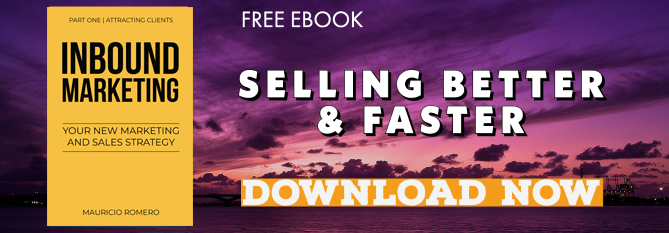
Choosing an advertising strategy is one of the main worries that businessmen share with us. Aside form the traditional marketing and advertising strategies, we now also have digital and social networks strategies. Which criteria should you use in order to decide which one will have a biggest impact on you business?
The objectives of a strategy can be divided into several kinds such as: push or pull strategy, positioning, share of mind, loyalty, branding, outbound or inbound, etc ... However, the ultimate goal of all these strategies is to attract potential customers to our business by creating familiarity and trust.
Regardless of the kind of strategy that you will consider, you must have basic criteria in order to better evaluate the options that you have for generating a greater impact on your business' growth.
Since the resources of companies are limited, you usually have to choose only one strategy from among the many options that you have. Few companies have the budget and resources to use them all at once.
For this reason, we suggest here 8 basic questions that will make your choice easier.
1.- What sales potential does the advertising strategy offer?

Any business is based on an investment and a return -that must be greater than the investment done. That is why, profitability is the first thing that you should evaluate in a marketing and advertising strategy.
We have met many customers and agencies that give their services to them who are not clear about this matter. Profitability is basic and many strategies can loose this focus.
For example, many agencies in digital advertising strategies measure their return on likes and not on the income that they generate. Or in a traditional strategy, when hiring a billboard, it is hard to measure how many prospects and sales are generated by that investment.
Now, not all strategies are measured only by sales and investing in branding is a long-term strategy that does generate profitability. But unfortunately, only large brands have the time and money to invest in them. If your company is a small or medium one, you must always focus on profitability.
What we have learned after more than two decades of making publicity, is that digital strategies require a smaller investment and have more profitable results than traditional strategies, being thus, a more tangible investment possibility for medium-sized companies.
2.- How much does an advertising strategy or marketing strategy cost?

We always want to know the cost of any product or service. This is one of the most important variables to buy anything. However, the cost of a marketing and advertising strategy can vary a lot. What we must evaluate -once again- is the profitability of the strategy and this should be based on the following question:
What result can I expect from this strategy?
If we don't have a clear answer to this question, we might be investing on something that will turn into a bottomless barrel or into a strategy that will have such a poor impact, that you might as well throw your money away... it's best to do nothing at all!
I understand that as a reader, the answer to this question that you expect is a specific number. Yet, in a matter that has so many variables and objectives, it is hard to answer with precision. However, there is a metric that can help us assess the amount of money that you should be investing, and it should be a percentage of your sales.
In our experience, a company must be investing between 7% to 15% of its sales on marketing . And the profitability of this investment should be at least equal to or greater than zero, otherwise it would make no sense to invest at all.
If the company invests less than 7%, the impact could be very low, and investing more than 15% is something that only companies that have very high margins over their products or services can do.
3.- How long does it take to get results with that marketing and publicity strategy?

Without explaining too much of the strategies that must be carried out, we must first focus on the strategies that generate the greatest impact in the shortest time. By doing so, we can take care of the limited resources that every company has.
Afterwards, we must have a long-term vision that contributes to the strategy of creating familiarity and trust in our customers and not only in immediate results reflected on sales. So this would be a strategy that also needs to be taken care of.
On what do each one -or both- depend? On the size of the business and the need to generate additional resources.
This dynamic between short and long term objectives is something that each company must decide according to its current position.
A strategy must at least take an annual duration. If we are thinking in less time, what we are really doing is a small campaign that can not be categorized as a strategy. It would be an allied effort or a test.
The annual strategy is to carry out a series of activities during 12 months in order to expect good results. It is not creating a campaign and then waiting 12 months to see if it had results.
And a long-term strategy would be from 5 years and up. This is a much longer and hard-to-evaluate period of time for medium and small companies.
4.- Is it a strategy consistent with the corporate culture of the company?

Some strategies require the participation of many people within the company, not just the marketing area. General management must support the strategy by providing all the necessary resources to carry it out; the commercial area should include marketing and sales with clear objectives and metrics; the rest of the organization (such as as operations, finance and production) must give its support with technical content and with the delivery of the product value. All of it just in order to be able to keep the company's promise, which is to solve the problem or need of the client.
We must evaluate if we have an organization that is really participative, dynamic and if they are are on the same side in order to carry out the strategy.
We have come across many companies that are not prepared to take the required marketing strategies to action. This usually happens because:
- The different departments do not feel a part of it
- It has not been properly communicated to everyone why it is important for everyone to participate
- The organization is so "thick" so inflexible, that any structural change becomes an even more complex process
5.- Will it contribute with other objectives?

In general, a good marketing strategy permeates the culture of the company. In terms of growth, it must always meet other objectives as well. For example, when we implement a digital marketing and sales strategy, we not only contribute to achieving business goals, but also to the development of the staff and to the use of technology systems that help make their tasks easier. It also helps the consumer to better understand what is it that we do and teaches him how to buy and use our product or service.
For example, whenever an inbound marketing strategy is implemented, it contributes to the training of both the sales and marketing staff, helping them to look after the same objective and to reach metric agreements as a team.
In terms of technology, we implement tools such as a CRM, along with training for using it. With this tool, the sales and customer service teams can give a better service to their prospects and clients. And the operations team gets trained in order to be able to explain what is it that they do and on what a marketing and sales message can become, as a differentiator of the company.
6.- Does it create an advertising asset?
Check that the materials that are used during the strategy can continue to be used in the future so that they don't become an investment that fades right away.
Usually, the ideas and the content used to differentiate the brand are assets that can last a long time. As an example, think of the articles that are published in a blog of the company, whose purpose is to answer a question that a client regularly has. They are posted and stay there for as long as needed!
One of the assets that are also generated in digital strategies is the information generated during the entire process (podcasts, videos, web pages...)
7.- Will it last in time?
As we mentioned before, the duration of a strategy must be evaluated in the short, medium and long term. However, there are assets that are made in the strategy that continue to work with the passing of time, even long after the period in which we evaluated their production. As an example, we have a logo or the slogan of the brand. These last a long time and are part of the personality that we use to differentiate ourselves.
Another example of this are blogs and articles. In digital marketing, we have seen articles that were written back in time, probably more than three years ago, that continue to generate visitors to the website and, the people who read them, continue to contact the company to start a conversation with it about the product or service that is being offered .
8.- Where does it place you facing the competition?

A strategy must always gain ground against the competition, be it in positioning, market penetration, or differentiation. Which is why it is important to know the strategies that the competition is carrying out in order to understand:
- How the market behaves in general
- The messages that becomes successful with clients.
We many times can create strategies focused on correcting misconceptions that other brands have created regarding our product or service in general. This can help your company differentiate itself very quickly, while also educating your potential customers.
Based on these 8 questions, you can quickly and objectively evaluate the possible impact of each strategy and thus, invest the resources of the company in a smarter, better informed way.

